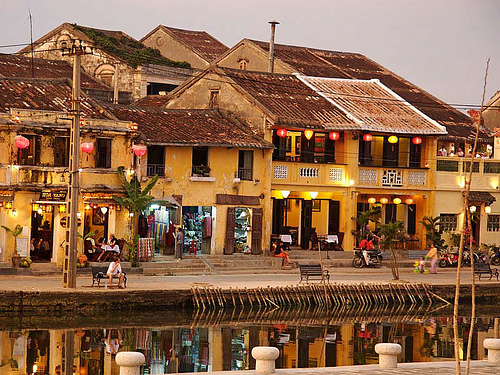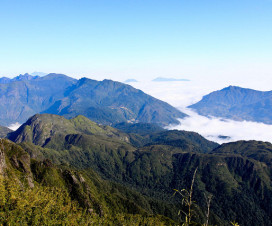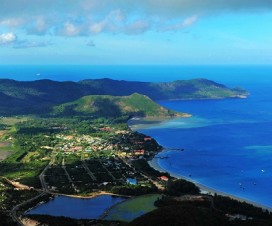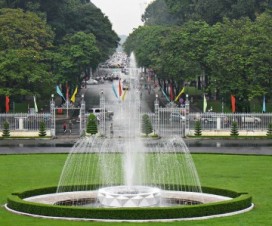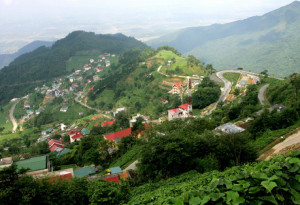 Nestled high up in northern province of the Vinh Phuc, Tam Dao is perhaps the perfect respite from the heat and humidity of Ha Noi. Nestled high up in northern province of the Vinh Phuc, Tam Dao is perhaps the perfect respite from the heat and humidity of Ha Noi.
Tam Dao is just 86km northeast of the capital. The town, occupying 253ha, is 900m above sea level in the heart of Tam Dao National Park – the largest in the north. The 80km mountain range has three prominent peaks, which is why it is named Tam Dao. The middle peak is called Ban Thach (Stone Table) and stands a proud 1,388m. The left peak is named Thien Nhi (Sky Market) and is 1,375m tall, while that on the right, named Phu Nghia, is 1,400m above sea level. The French hill station is famed for the wraith-like mist that shrouds the town most mornings. By midday the fog lifts to reveal a mind-boggling panorama of hills and forests. The afternoons are typically cooler, while at night a chilly wind makes heavy clothing a must. In fact, each day in Tam Dao is like the four seasons of the year – summer, autumn, spring and winter. Leading up to the town is a thin ribbon of road 20km long rising from the plain, while a silvery stream circles the town like a silk scarf around the slender neck of an enchantress. The town is an ideal hideout for authors, which is why an annual writing competition is held in Tam Dao. Adding to the splendour of Tam Dao are the vestiges of old French colonial houses dating from the early 20th century harking back to the days of European rule. In all, there are about 200 colonial buildings still standing, but few can remember the days of the French. Local culture official Do Dinh Chuc introduced me to Nguyen Huu Duyen and Luu Ngai. Duyen, now in his seventies, who is a descendent of one of the first families to settle in Tam Dao, some 104 years ago. Ngai used to work as a maid in one of the French’s villas. That said, both remember only too vividly 1946 when locals applied the scorched-earth policy and destroyed the last vestiges of colonial rule during the Vietnamese war of resistance against the French. Further information can be gleaned from the sixth volume of Indochina magazine published in June 1914. The magazine reads: “In 1904, a delegation sent by the Office of the General Governor of French Indochina sought a suitable place in the Tam Dao mountain range to build a summer resort. “The delegation reported that they had found a suitable locality at a height of 930m. After two years of careful examination, the office began work in 1906 on the hill station.” The French occupied the town for the next three decades before it was totally destroyed in the war of resistance. In its heyday, the town had 143 stone-built villas, some owned by wealthy Vietnamese such as Ho Dac Diem, Hong Khe and Phu My. The architecture in Tam Dao is reminiscent of Sa Pa, Da Lat and Ha Noi, a blend of the old and the new, and gave the nostalgic colonialists a taste of home. The stone walls were typically 60-120cm thick. The slate for the roofs was imported from Toulouse and Marseille. Little now remains. Duyen and Ngai said life for them and the other 6,000 Vietnamese in the region was hard. Most served the wishes of their colonial masters. They were not allowed to settle in the town. Instead they were forced to live 2km away. Today Tam Dao has 60 hotels and guest houses that are owned by 17 families. The district received about 1 million tourists in the first six months of this year, which is a 50 per cent increase against the same period last year. The remaining 200 inhabitants earn a living from farming and growing su su (the local name for chayote). “Chayote here are more delicious than those in other places such as Sa Pa,” said Do Quoc Hai, a tourist from Ha Noi, while eating a bowl of chayote that had been stir-fried in oil and garlic. Green chayote trellises laden with fruit can be seen everywhere. About five tonnes are picked each day. In fact, the unique taste of the fruit has become synonymous with Tam Dao. And when visitors reluctantly have to return to the noise and pollution of the city, a basket of the fruit is a happy reminder of the halycon days in the hills. Source: VietNamNet/Viet Nam News |

